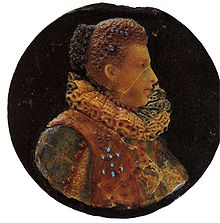
Back Ceroplastika Czech Keroplastik Danish Ceroplastik German Ceroplástica Spanish Vahakuju Estonian Zeroplastika Basque Céroplastie French Ceroplastica Italian 蝋人形 Japanese 밀랍 인형 Korean




A wax sculpture is a depiction made using a waxy substance. Often these are effigies, usually of a notable individual, but there are also death masks and scenes with many figures, mostly in relief.
The properties of beeswax make it an excellent medium for preparing figures and models, either by modeling or by casting in molds. It can easily be cut and shaped at room temperature, melts at a low temperature, mixes with any coloring matter, takes surface tints well, and its texture and consistency may be modified by the addition of earthy matters and oils or fats. When molten, it is highly responsive to impressions from a mold and, once it sets and hardens, its form is relatively resilient against ordinary temperature variations, even when it is cast in thin laminae.[1] These properties have seen wax used for modelling since the Middle Ages and there is testimony for it having been used for making masks (particularly death masks) in ancient Rome.[2] The death masks of illustrious ancestors would be displayed by the elite holding the right of "ius imaginem."[3]
- ^ Chisholm 1911, p. 430
- ^ Chisholm 1911.
- ^ "Funerals in Ancient Rome". Mariamilani.com. Retrieved 22 April 2013.